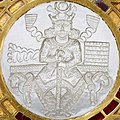Dokhtar-i-Noshirwan
 Royal enthronement scene at Dokhtar i-Noshirwan. | |
 Shown within Afghanistan | |
| Alternative name | Dokhtar-i-Noshirwan |
|---|---|
| Location | Samangan, Afghanistan |
| Coordinates | 35°45′33″N 67°52′34″E / 35.759179°N 67.876073°ECoordinates: 35°45′33″N 67°52′34″E / 35.759179°N 67.876073°E |
| Type | Settlement |
| Site notes | |
| Excavation dates | 1928 |
| Condition | Ruined |
Dokhtar-i-Noshirwan, also Nigar, is an archaeological site in the Ḵolm valley in northern Afghanistan.[1][2] It is located 100 kilometers north of Bamiyan and has the largest non-Buddhist mural in Afghanistan.[2]
The mural represent a local ruler, possibly Hephthalite,[3][2] in an attitude similar to that of Khosrau II on one of his silver plates: seated frontally with legs spread out and his hands on a large swords standing between his knees.[2] The crown is formed by the head of a beast, framed by two wings, similar to a design known from the coins of Shahi Tegin.[2]
The artists of Dokhtar i-Noshirwan for may have come from Bamiyan or Kakrak.[3]

Silver plate of Khosrau I (531 to 579 CE).

Plate depicting the Sasanian king Khosrow I (531 to 579 CE).

A coin of Shahi Tegin.
References[]
- ^ "DOḴTAR-E NŌŠERVĀN – Encyclopaedia Iranica". iranicaonline.org.
- ^ a b c d e Rowland, Benjamin (1974). The Art of Central Asia. p. 94.
- ^ a b Klimburg-Salter, Deborah (1993). "Dokhtar-i-Noshirwan (Nigar) Reconsidered". Muqarnas. 10: 355–368. doi:10.2307/1523200. ISSN 0732-2992.
- Archaeological sites in Afghanistan





